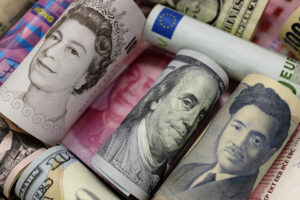MORE short-term foreign capital left the Philippines than entered for a second straight month in April, data from the Bangko Sentral ng Pilipinas (BSP) showed.
BSP data showed that transactions on foreign portfolio investments registered with the central bank through authorized agent banks posted a net outflow of $312.18 million in April.
This was smaller than the $351.87-million outflow in the same month a year ago. However, net outflows widened from the $236.02-million outflow seen in March.
Foreign portfolio investments are commonly referred to as “hot money” due to the ease by which these flows enter or leave the country.
Gross inflows jumped by 28.2% to $913.62 million in April from $712.83 million in the same month a year ago. Month on month, inflows fell by 35.1% from $1.4 billion in March.
The bulk or 59.5% of investments went into Philippine Stock Exchange (PSE)-listed securities, mainly in banks, holding firms, property, transportation services and food, beverage and tobacco.
The rest of the registered investments went into peso government securities.
The BSP said that the majority of total foreign inflows (87.9%) came from the United Kingdom, Singapore, Luxembourg, and Hong Kong.
Meanwhile, gross outflows stood at $1.2 billion during the month, 15.1% higher than $1.1 billion a year ago.
On the other hand, outflows declined by 25.4% from $1.6 billion in the previous month.
By destination, almost half or 43% of total outward remittances went to the United States, equivalent to $527 million.
For the first four months, hot money yielded a net inflow of $65 million, a turnaround from the $680-million outflow in the same period in 2023.
Rizal Commercial Banking Corp. Chief Economist Michael L. Ricafort said that the decline in hot money outflows may be due to geopolitical tensions.
“The narrower net foreign selling may have to do with the easing of geopolitical risks between Israel and Iran with no new response between the two since April 20,” he said in a Viber message.
“Inflation still within the BSP’s target despite some slight pickup in recent months is also an offsetting positive factor, as global crude oil prices still hovered among two-year lows or since January 2022 recently,” Mr. Ricafort said.
Inflation accelerated for a third straight month to 3.8% in April from 3.7% in March. However, it marked the fifth straight month that inflation settled within the central bank’s 2-4% target range.
“Risk factors that still contributed to the net foreign selling recently include the El Niño drought that led to higher local rice prices and weaker peso exchange rate that led to some pickup in inflation,” he added.
Leonardo A. Lanzona, an economics professor at the Ateneo de Manila, said in an e-mail that the central bank’s latest signals could impact hot money flows.
“While the more stable inflation rate has reduced the outflows to some extent, the announcement that BSP will moderate its hawkish position on interest rates can bring about substantial outflows and lead to some financial instability,” he added.
BSP Governor Eli M. Remolona, Jr. has said the central bank can start cutting rates as early as August. The central bank could cut by 25 to 50 basis points (bps) this year, he added.
The Monetary Board has stood pat for five straight meetings, keeping its benchmark rate at a 17-year high of 6.5%. It raised borrowing costs by a total of 450 bps from May 2022 to October 2023.
“In addition, the current depreciation of the peso can lead to even higher outflows,” Mr. Lanzona said.
The peso sank to the P57-per-dollar level for the first time in 17 months in mid-April.
On Friday, the local unit closed at P58.51 per dollar, strengthening by 12.5 centavos from its P58.635 finish on Thursday. Its close on Thursday was the peso’s worst finish in almost 19 months or since its P58.80 close on Nov. 3, 2022.
Mr. Lanzona noted that hot money flows may also be driven by “speculative behavior” where investors capitalize on short-term market movements that lead to rapid inflows and outflows of capital.
“It’s important to note that hot money flows can be highly volatile and sensitive to market sentiments, making them a potential source of financial instability for economies heavily reliant on foreign capital inflows,” he added.
The BSP expects foreign portfolio investments to end the year at a $1.3-billion net inflow. — Luisa Maria Jacinta C. Jocson






